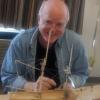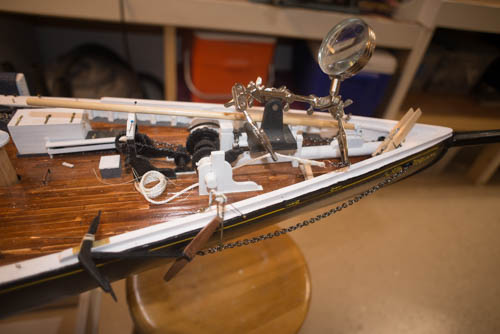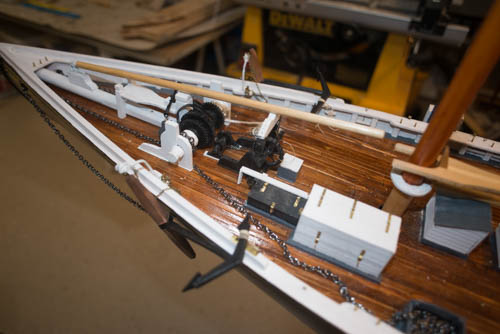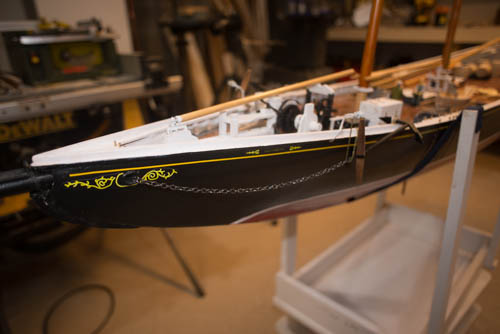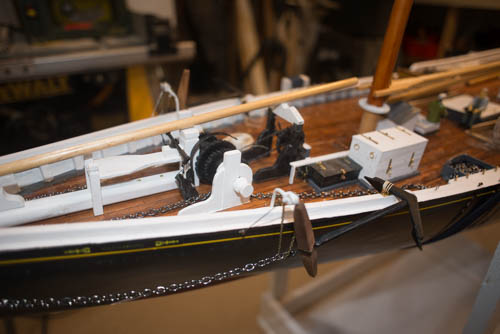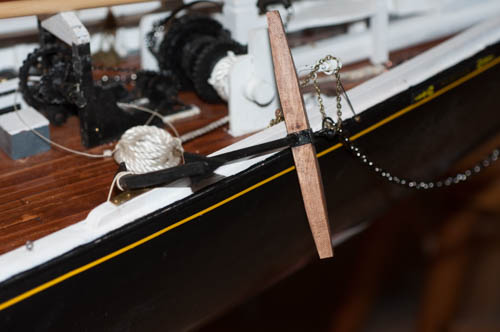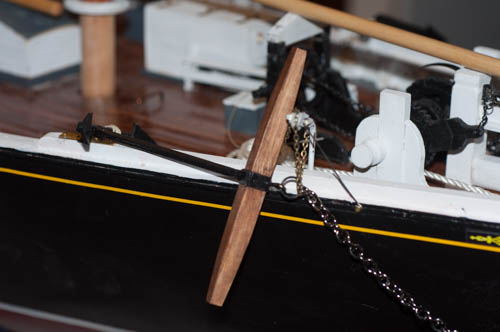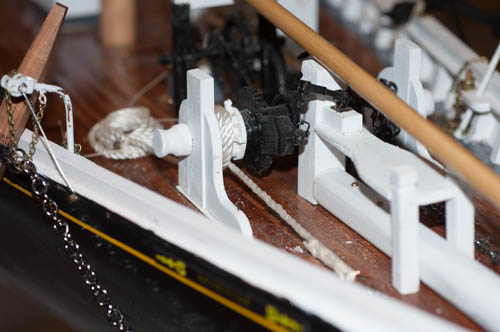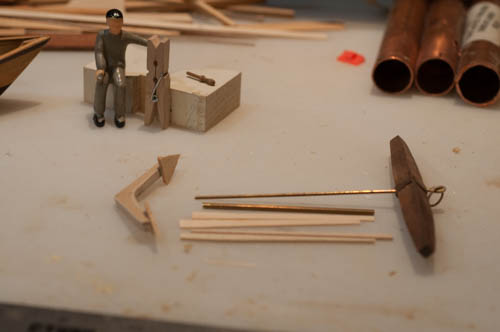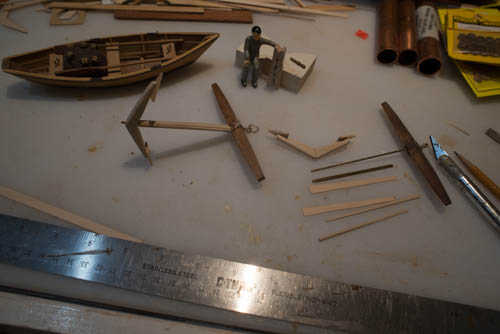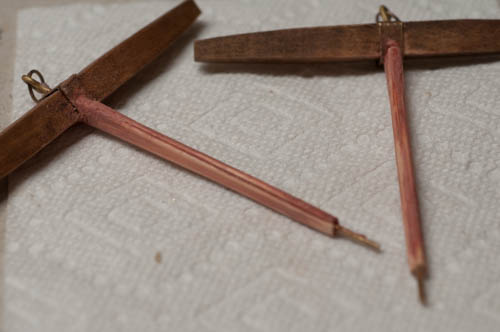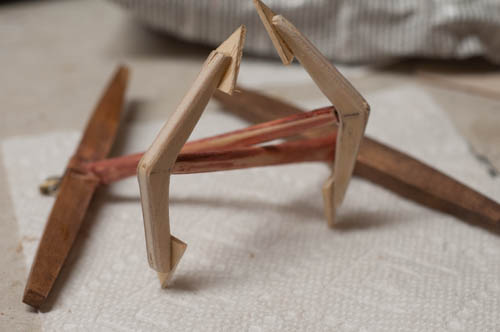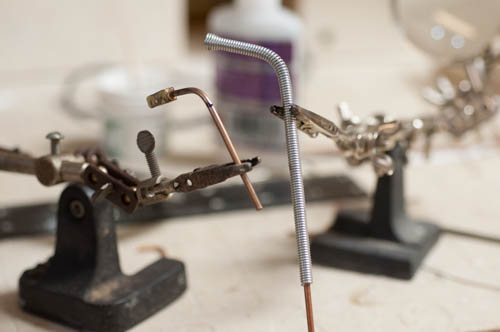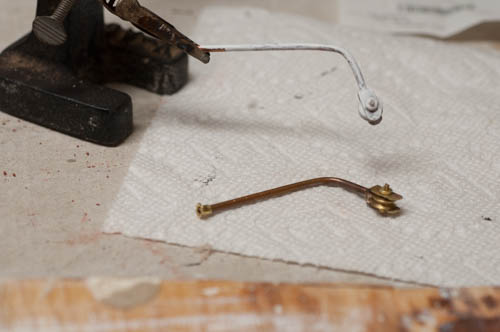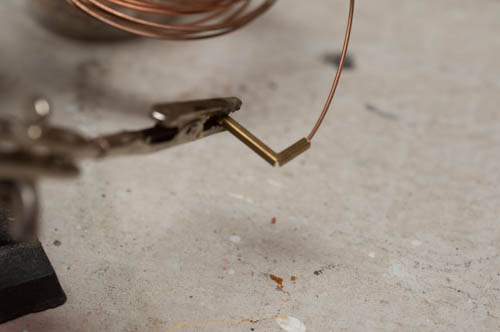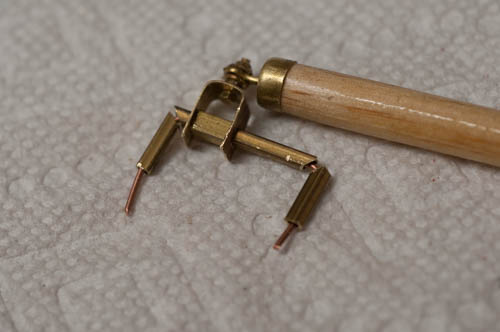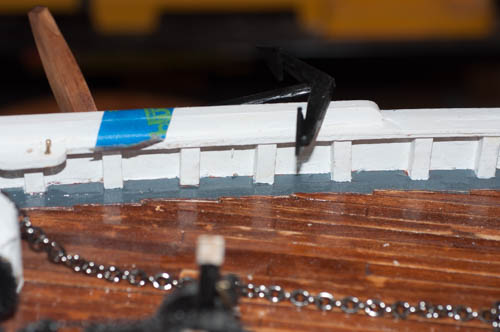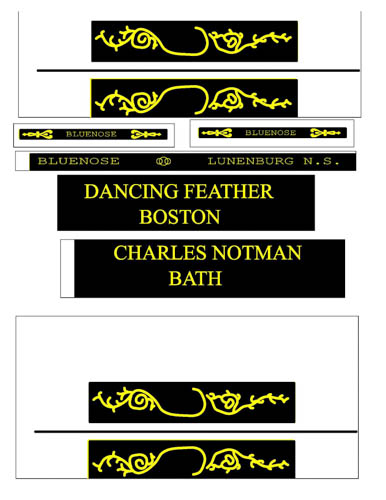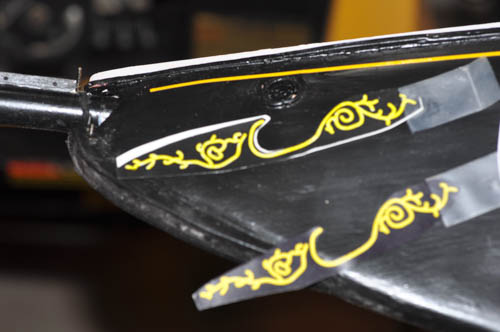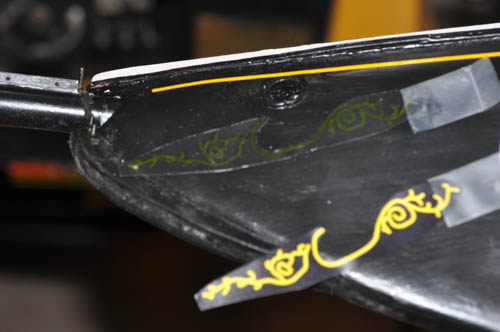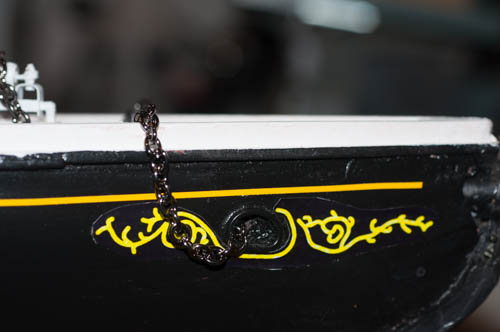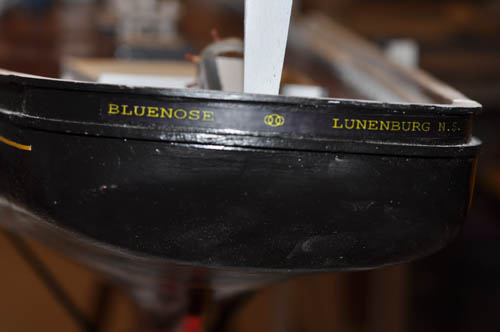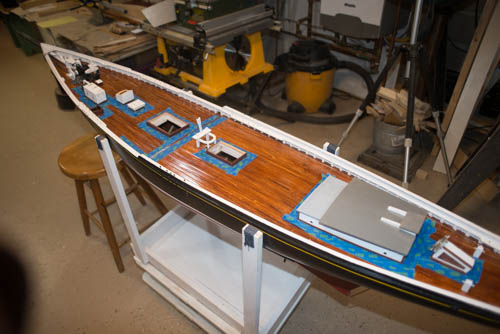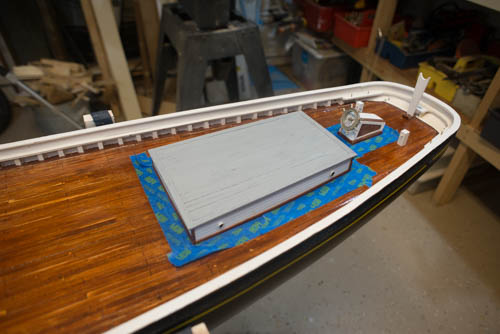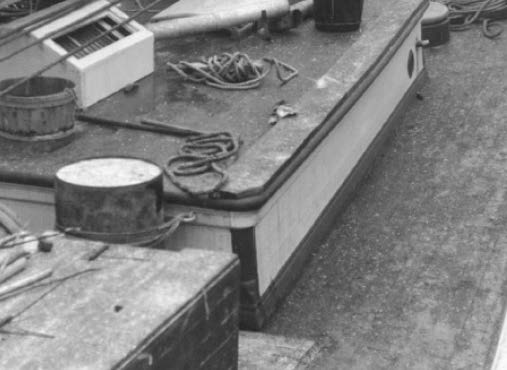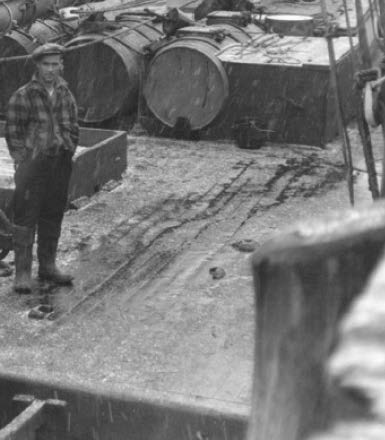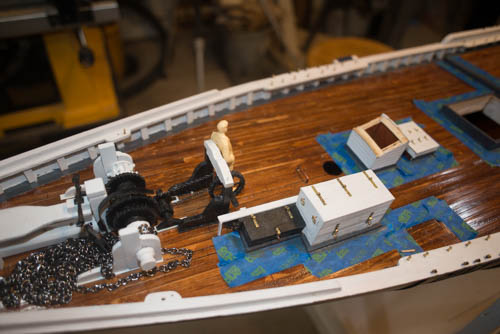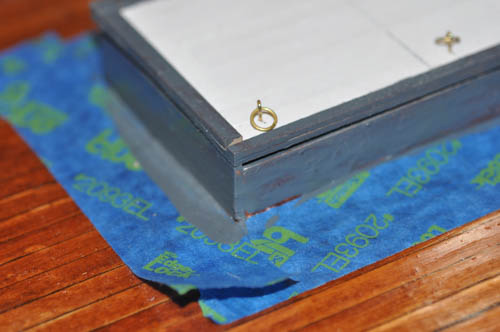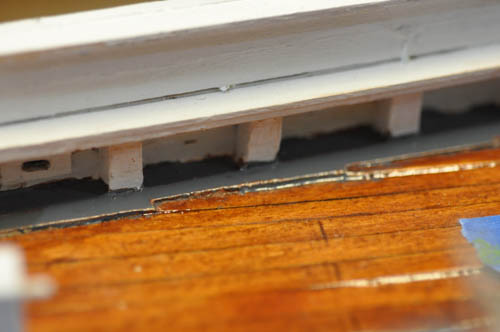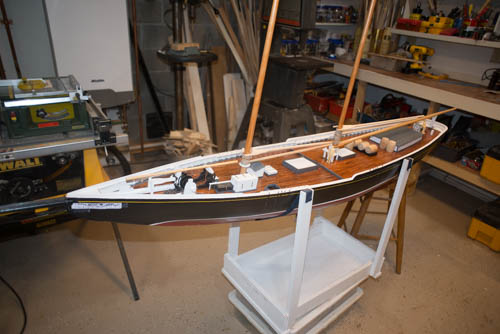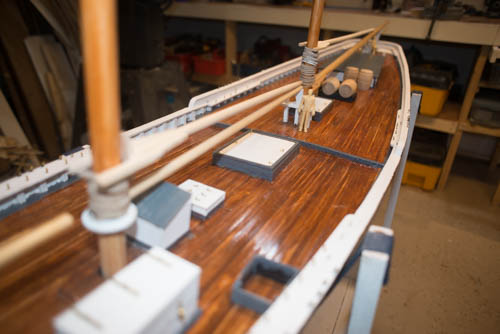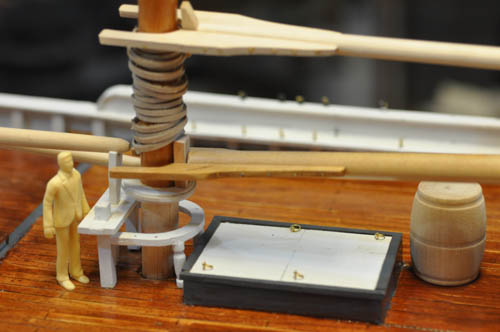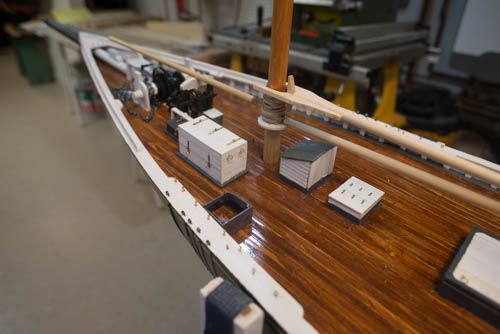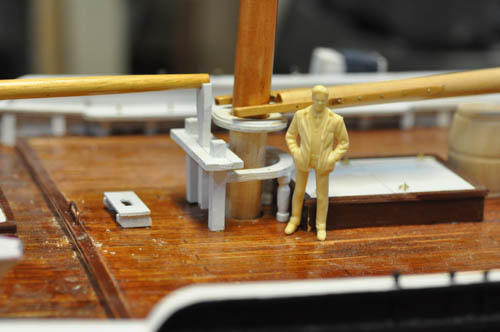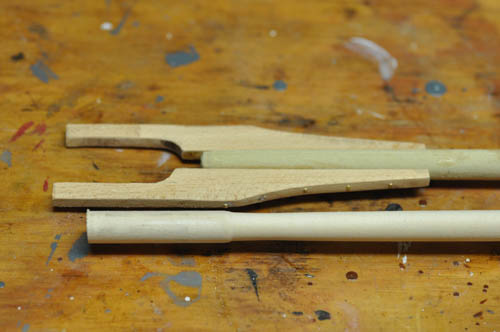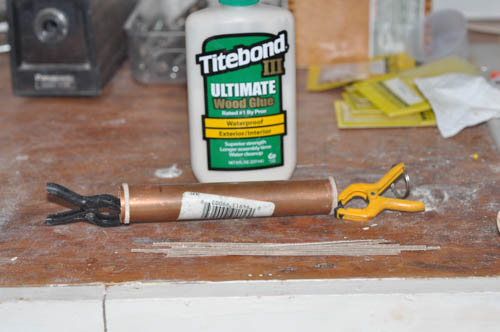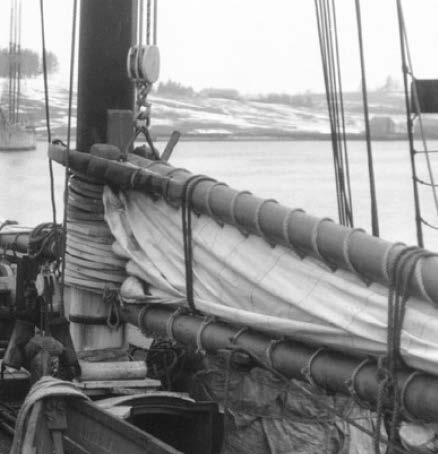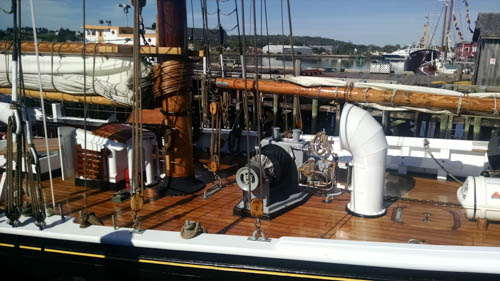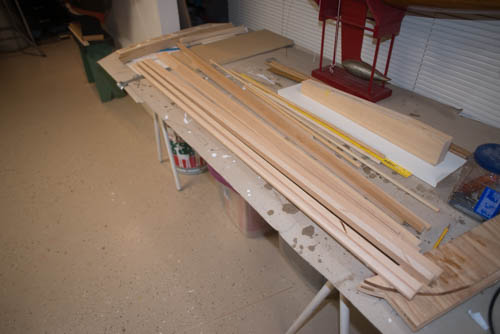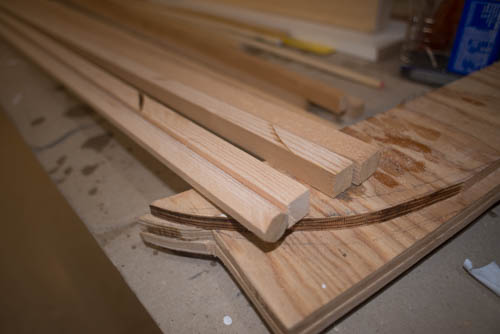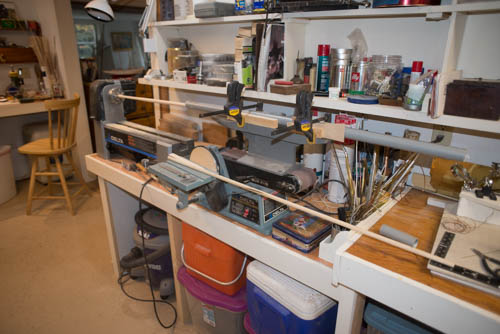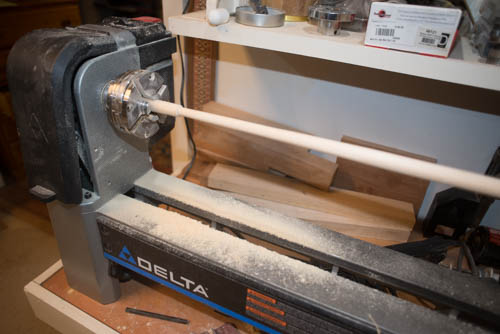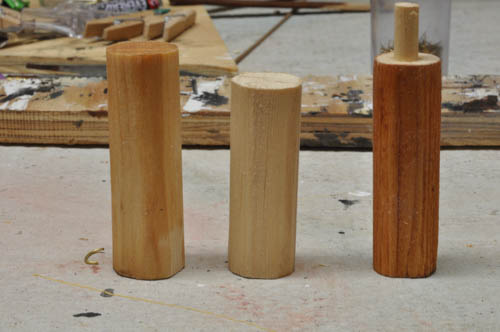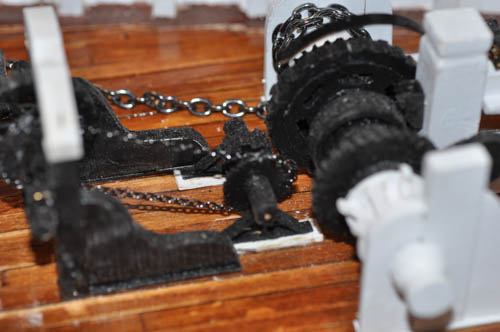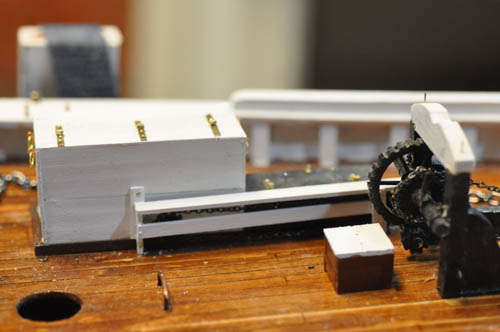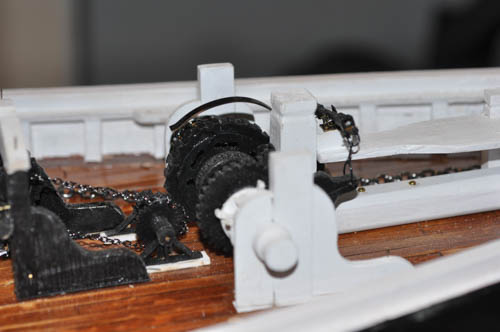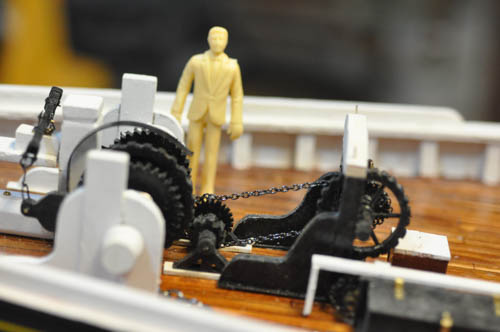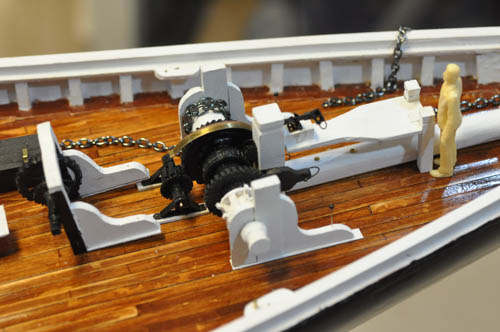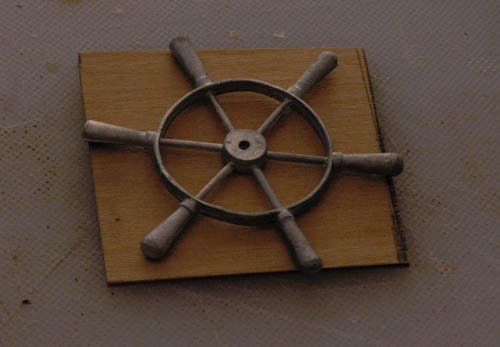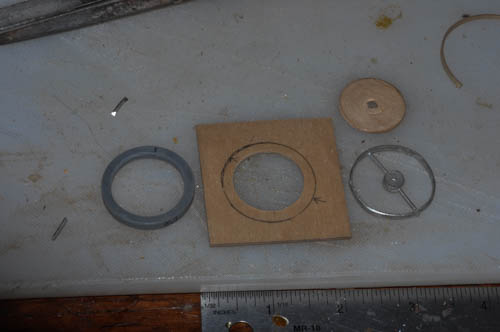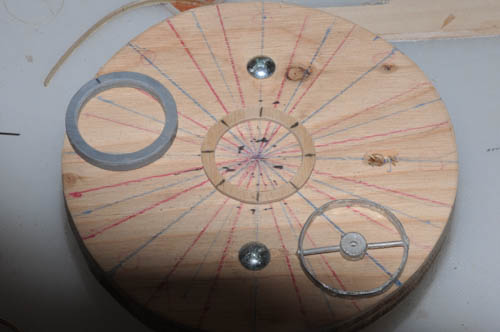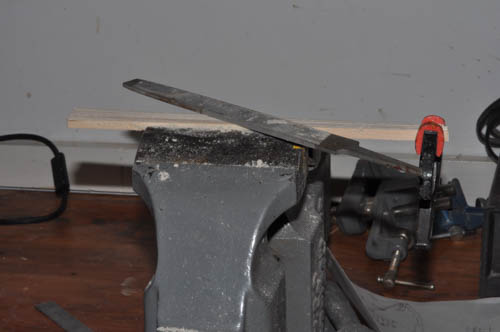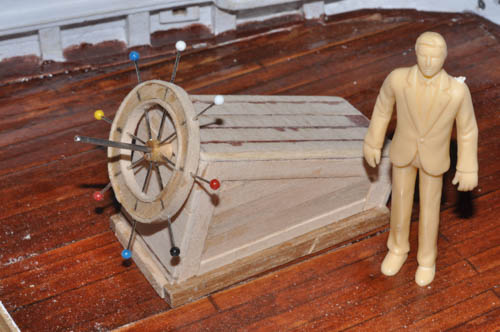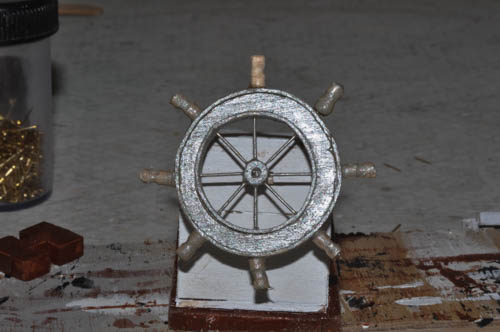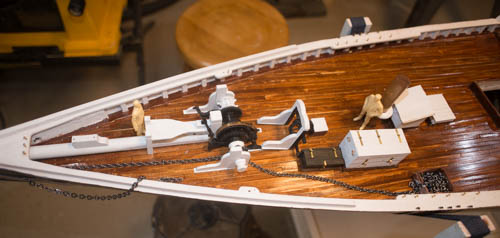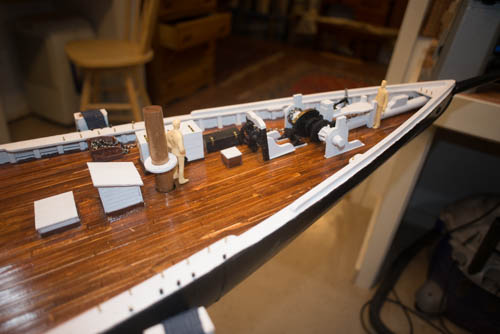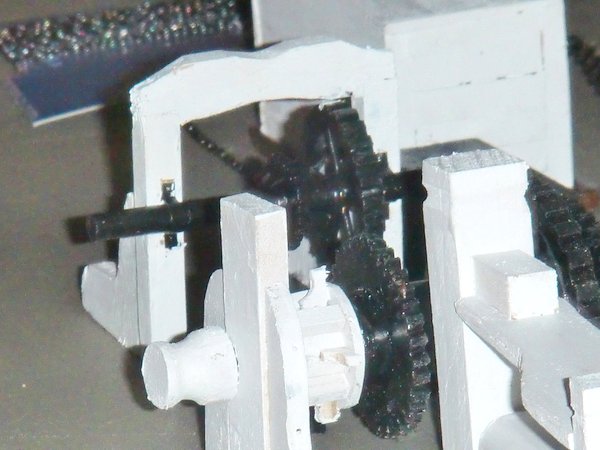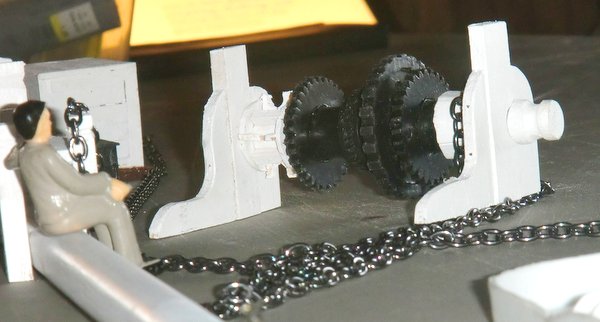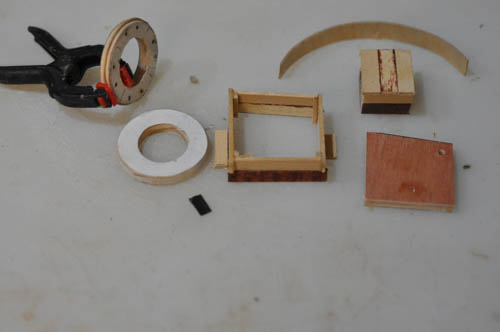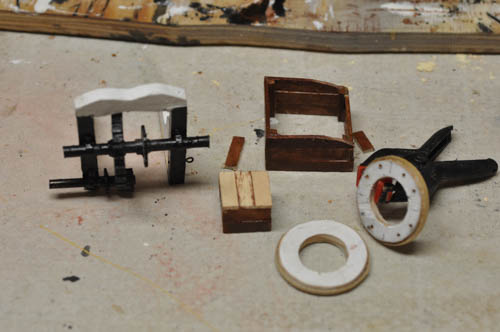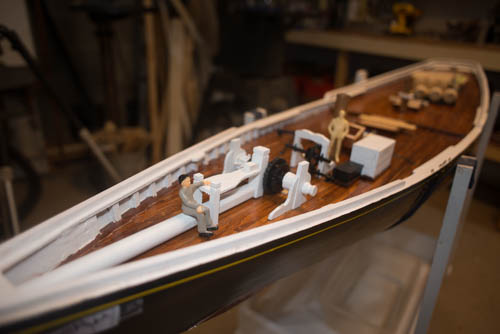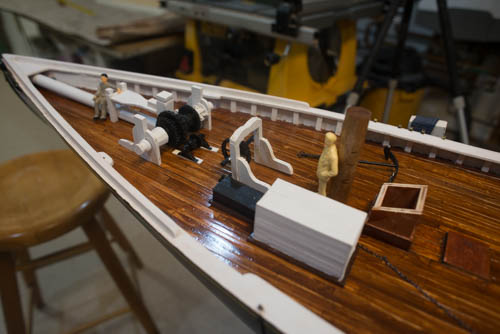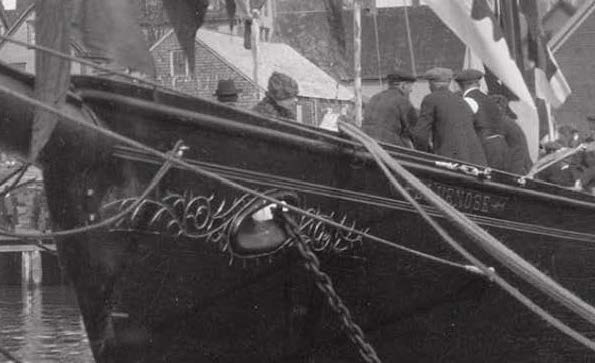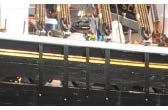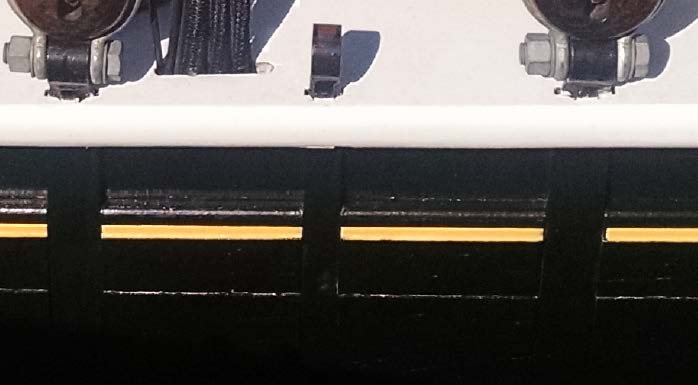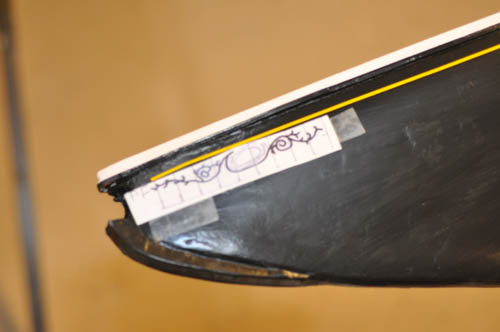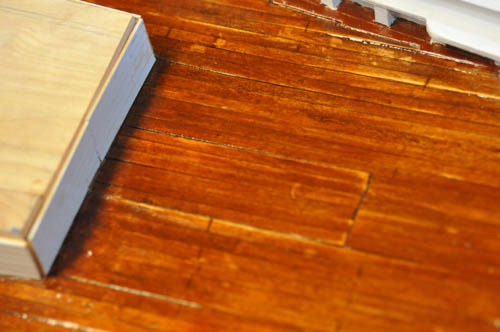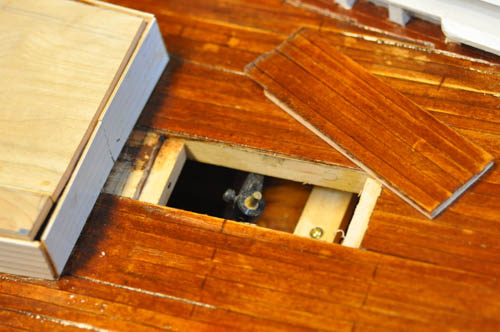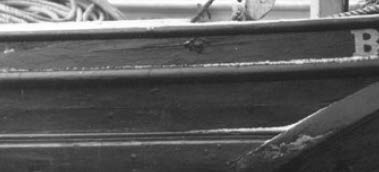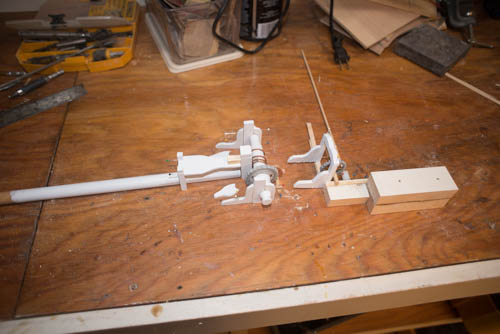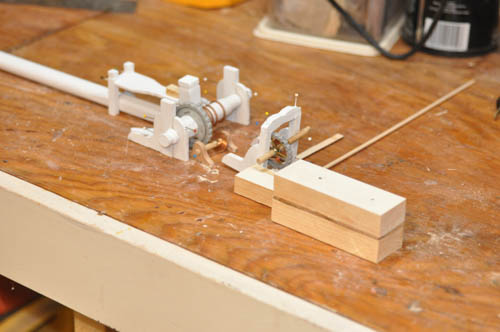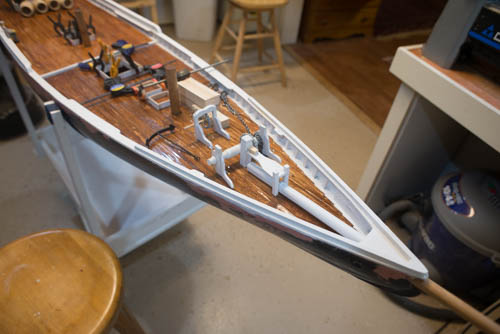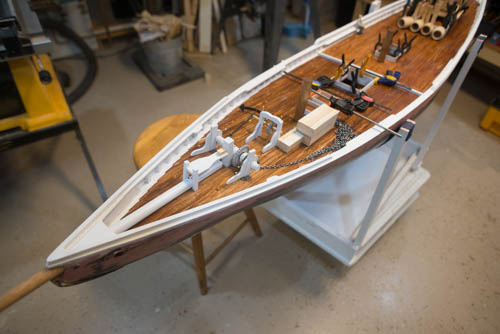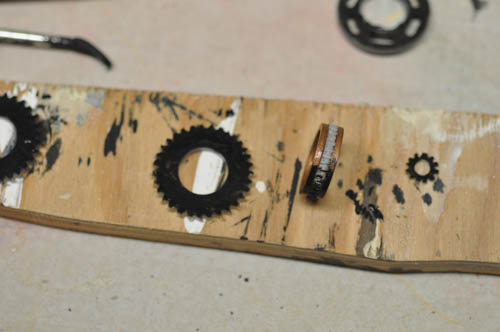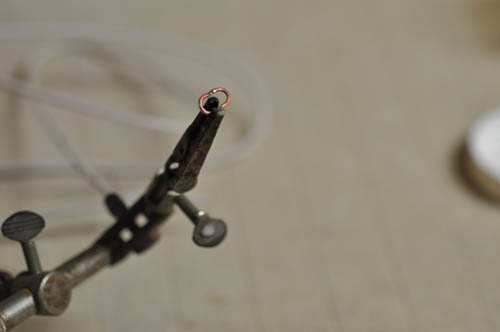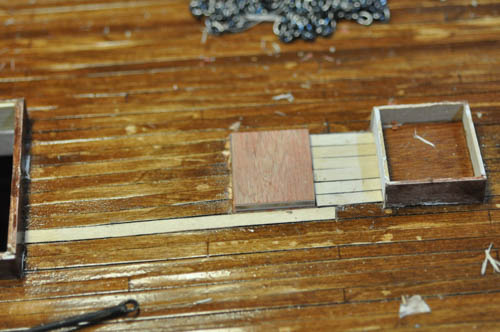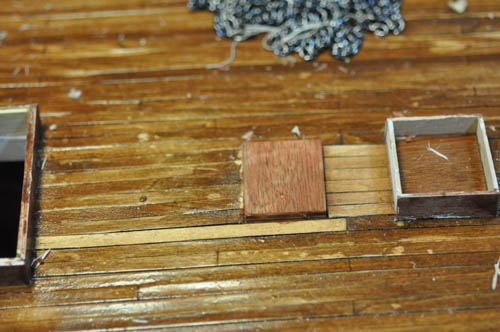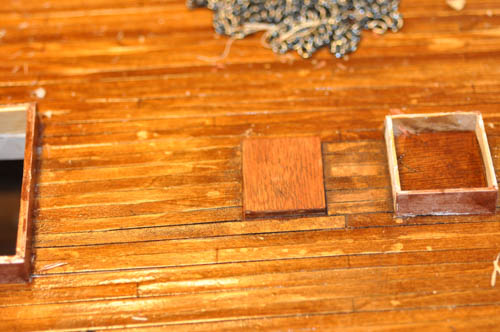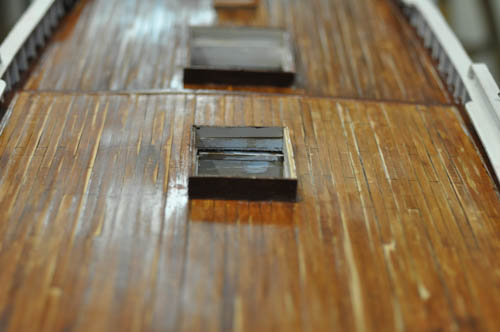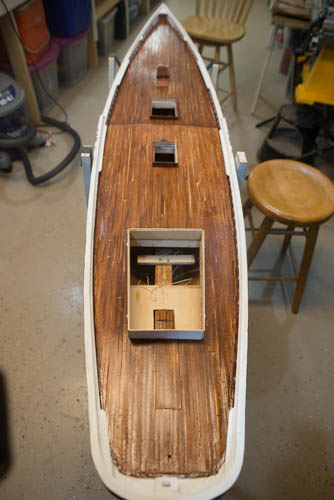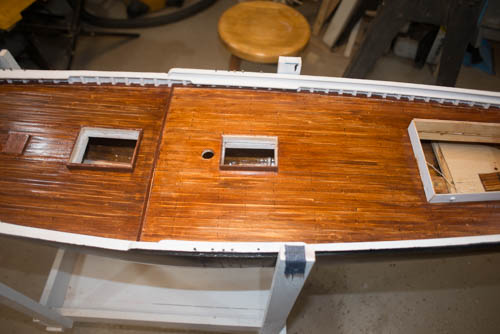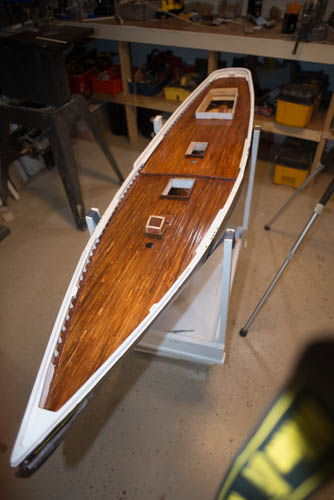-
Posts
856 -
Joined
-
Last visited
Content Type
Profiles
Forums
Gallery
Events
Everything posted by Jond
-
Thank-you for comments I loved the build. They are really a bit big for display. I am working and learning to enjoy 1:24 scale and that would be about a foot. I hope to do that next year if I can ever make my dories for Bluenose. Cheers Jon
-
I put on the anchors and bent an anchor rope to the starboard side. This is the type detail work that takes me away for actually RC sailing. we'll see Here is another sequencing issue. I needed to bend the anchor line and by the time I got there I needed to do it insitu. I chose to use a nylon line I had on hand at this point just to see where I am going. I will replace this line later when I figure out a larger rigging plan. The archive photo could be misleading as it shows what must be a 3 inch braided line. That would be 1/8" in this scale and easy to find if i find that is correct. the line here is twisted and just a hair bigger. This is an overview of both anchors lashed in place. The fluke pads are brass and will eventually be painted out. This view shows my dilemma for a sailing model. This anchor chain would catch water and do something naughty. Maybe I just tape it up and out of the way? Here I see in the photo the port side cat head chain has slipped out. I need to consider if I want this sheave to work or glue it all up. At the moment they both turn and the chain sits loose. Not enough weight to put on tension and hold it in place. I also think I want to be able to demonstrate bringing the anchor up to this position and using a spoon to bring her aboard. A detail view from behind starboard side. At this large scale I had to tie a little bowline in the fluke lashing line and then make it up on the falls. A detail from forward of the starboard side. I want to give credit to the Howard Chapelle The American Fishing Schooners book appendix notes for laying out this rig. Here the rope rounds the winch and goes to coil. There would have been several shots of line on deck. I have seen in the Lunenburg Museum other models with a large coil and that is what I will show. I need to decide if braided or twisted first. This tease photo indicates the wall I realize i just hit. So far two of the dories I have made are prime kindling. Watching a another scratch log now being posted for a similar size boat, I realize i did not give the dories enough respect. At this scale they are really 6 more models. So I need a strategy session to figure...what to do???. On Charles Notman i made a solid block for the yawl boat and faked a canvas cover for the sailing; I even removed it while on the pond. I plan to build the real Yawl boat in the future. I will build the dories and try to improve them from my first attempts. This may take a while. cheers
-
Chris I just found your log late last night. I love working in this scale and am happy to follow along as you look into and solve a myriad of problems unique to the larger size. I am a learner and that is the most rewarding part I find in this new trade. I am currently scratch building Bluenose at the 1:24 scale and am just about to hit the wall as I get to start rigging. i experimented yesterday to lash the anchor and had to tie a real bowline. What size line matters, knots mater as do blocks and things. I just got a seizing machine and plan to spend this next winter learning the new trade. anyway I wanted to say hi and let you know I am following with much interest. cheers
- 54 replies
-
- glad tidings
- model shipways
-
(and 1 more)
Tagged with:
-
Hi Jerry I'm back again and taking a look at lines and rigging. You are doing great. My larger scale...1:24.. makes everything very visible. I need to learn seizing and things like never before. I am also working hard to make decent dories. Anyway I look forward to seeing what you and others are doing. These logs also get us to all kinds of hints. My log link is to a scratch build. You can see if you visit I am getting close to rigging. Thanks for sharing. Cheers jon
-
This week is a part making week. I needed to figure out anchors, the car and track set up for the fore-staysail boom and the anchor cat heads. I struggle a bit at this scale as things should sort of work. Also in the case of the anchors I want them to be light so they stay in place. Starting off I chose to work in materials where I am most comfortable. that usually includes wood and brass/copper. The stocks are easy...they are wood. It is the shank,crown and arms that are tricky as I am not a 'caster". The eye and diamond shaped bracket around the stock was tricky. I bent a thin 1/4" by 1/64" brass strip and soldered it . I then drilled opposite corners to fit a 1/16" brass rod. I twisted a small eye into the top of the rod and added a soldered brass ring to hold the chain. I took a 1/16" square tube and slid it up on the shaft to give me square sides. The thin wood strips tapered on opposite sides and fill in on the others are to be glued to the brass square tube to form the shank. The arms and flukes are easily shaped in laminated wood here one anchor is trial fitted, and the second is ready to go. after the shank wood glue dries, sanding,putty and more sanding get us to the real shape. here they are assembled. here the first one is painted out. now we need some more parts as we try to complete the fore deck. Here I got to use a small spring tube bender that I bought many years ago and until now never used. I want try making these in tube as that helps at both ends to attach things and also for a drilled pin to hold the chain. Drilling though solid brass is tough. The joke on me was after installing the cap screw in the next photo I had to drill through tube and screw for the chain pin. here I have shaped a bracket for the sheave. I was able to send a cap screw up the tube to attach the bracket and give strength. I also used some proctor airplane pulleys for the sheaves. here I am making the car and track for the fore-staysail boom. It is a rectangle in the archive photo. I have nesting square tubes and using the copper wire I can miter them to make a tighter bend than I could do if I tried to use a 1/16th " brass rod.A 1/8" by 1/16" tube would have been better. here the assembly is almost together. In the NS archive photo this all paints out white. I then need to add leather wrap to the end of the boom. I show this photo for two reasons. One it is a tease for what's coming as I mount the anchors. More importantly it shows a common issue of sequencing. As a complete amateur I continuously run into this. That nice cleaned up bulkhead need lots of fittings and now all the deck furniture is in place it is harder to get the drills and pliers etc in when needed . we'll see next time how I made out. I recommend one takes the time to put all the edge work in first. cheers
-
Today I want to share my low tech approach to making sign boards, scrolls and general lettering. I must say the 3D printing version of the scroll done on genericDave's site is the top shelf solution. My approach is simple printing. First what are we trying to do and second how did we try it. Here again thanks to the Nova Scotia archive site is a cropped image of real Bluenose and the sign board and scroll. This Photo and the Eisnor plan agree and that is what I chose to do. There are light shadows in this photo suggesting the scroll is carved into the planking, but that is not definitive. I also agree that it makes more sense to be carved in a shop and brought to the boat. The sign board is a full board but above the cove. Here I took a photo of the Bluenose ll scroll and it clearly is an applied detail. In this and other views one can see it is smaller and simpler than the original. I take it that notwithstanding 1962 was not 1921 the use of an applied scroll is the way to go. Here is the side sign board on Bluenose ll. Clearly it is a board added but in the photo it is large and covers the cove. So here we are. I laid these out in turbo cad and then filled up a letter size sheet. As you see I am remaking a few for other models and an extra set of scrolls in case...you know...I may need them. here I have tested a paper version to see I have size right... so far so good. Here I have been too smart for my own good. Since this is my first attempt, I ordered both clear vinyl and a white backed material I plan to use to make labels for storage boxes and bottles. Here is the clear vinyl scroll before I peel off the white backing. Oops!!!! Lesson learned. When I peel off the backing, the yellow disappears. Clear vinyl is useless in this application. Here I have re printed on the white label backing and voila...the white backing makes the yellow visible. Here is the other side...better photo... unfortunately the two yellows don't match. Some day I will figure that out. moving to the sign boards and transom Here is the port side sign board. I am not thrilled with the lack of boldness in the font. The flash photo also washed out the color. This font is the best of several attempts. It is so easy to change, however I figure when ever I learn how to do it better I can quietly change this out. Finally here is our sign on the transom. again. It is OK but I worked on this one the longest. The real one scales to 7 inches long. To get the names spread out and going back and forth in bold and not bold and using the few different fonts that have the squared letter highlight, this was the best I could get. The letters could be a little boulder. all for now cheers ,
-
Julian thanks. Charlie sits as shown in the last posting patiently waiting for me to get back to her. I have a another two months of intense work on Bluenose and then will start splitting my time to include more progress on both as well as a few other projects. I want to get past making sawdust and into rigging so i can do a good pre winter clean up. I also want to continue to get better making fittings, so I can fix a few weak points on Charlie cheers
-
A few postings ago I laid out four areas of upcoming work. let's see how we are doing. masts and spars on going but major work done...now detail color change brown to grey...rough in done and in this post out side graphics scroll etc ..almost done next posting dory's.....well the first one is kindling. I am now on second attempt on to the color As I have hinted before the grey is coming..but what grey Here is my first attempt by using what I had on the rough cabin roof. It was a great grey on a smaller older schooner but I don't like this here at all. Here you can see ... i feel it is just too loud. Here is a darker grey I used on Dancing feather. I neighbor on mine looked and said it was much more Navy...not sure it matters but positive comments do help us decide. Here again I have cropped a Nova Scotia archive photo to study tones. This roof looks dark and the cabin trim is dark too. I know on the larger four masted schooners this trim was often a natural finish but I don't believe it would have been on a fishing schooner. here is another cropped Nova Scotia Archive photo showing the hatches were dark. They seem lighter than what must be a black box in the back ground around the fuel [ I believe] tank. so I chose for the hatches and support curbs to copy the water ways, which as noted by Philip Eisnor where grey along with the cabin roof. So here I have taped off where I will repaint the deck curbs and hatches above the deck. here is one coat on the cabin roof. funny how it did not really cover. I need to wait until I add all the other things before I continue here. Not sure I want it to look like brand new paint I show this view of one coat. Note it does not really cover. Since the under coat is leather brown I find it an interesting affect that shows a natural wear. here the water way is painted. in this close up there is good and bad news. Some of the brown coming though is OK but the issue out of sequence repainting means I need to go back a few more times cleaning up the crispness of the white to gray corners. ouch! will it ever be right? here repainting the wheel I found it had natural handles . behind the figure I have sanded and stained the handles leaving the end metal for the cap. This scale means lots of extra work. The dark inner panel and top curved board show up in both photos of the 1940 survey and a sailing view. There are other pictures of the whole thing being white.That must have been during its earlier life. here we see joy in large scale as I can actually install the mid height supports and take the eye bolts down through as they are in life. This is unlikely for smaller scale. the bad news is look at the touch up painting I need to do and the difficulty since I changes color so late. oops. Here we see the new color and spars sitting in place. Here we get the feeling of the new color combination. better than brown but needs more clean up. I talked about making hoops. Here i set them unfinished to see how they are doing. In photos there are two colors. Most are dull and the other blond. I assume blond means new replacements. This is another thing to think about. Finally I wanted to share the beauty of Sitka spruce and larger scale. I happen to like the natural finished boom and its visible taper. No mater how ugly I make the boat this boom will hold its place. major lesson learned here by me.....make up your mind early on colors and then do not change your mind. Oh well all for now cheers
-
wow three guys looking at the same boat that understand Eskimos play football. And I do not mean soccer. It was the winter I spent up there when I started surfing the net and finding out how much wonderful information is out there on modeling. I have many fond memories. cheers
-
step 2 of the masts and spars. Today I actually completed turning my last two spars......maybe. . anyway onward we march. here I have the fore boom ,fore gaff and forestaysail boom all made from hardware store dowels and left blond. Not sure if like them yet. I need to decide before trimming them out. I may need to sand off varnish, lightly stain say cherry, and recover. they would not be this clean in later life like the deck. Also the spruce on Bluenose ll are very notty and a bit yellowed like form varnish. The new poly coats are too clear to create that look. here is the main boom. It is in Sitka and came out well. It is not finished yet in this photo. that is coming. here one can see the huge size of this 80 foot spar [ 40 inches] in this large scale. wow it is almost a table leg. Here we see the affect of the clear varnish only below the boom like Bluenose ll. I like it so far but may later remove mast and paint out in white. Here you can see also the main mast and its finish treatment with more items . I have added the fore boom, rails, horse and foresail lizard box [ or whatever one calls it]. now some fun see if you can tell what's wrong here. I did not measure twice before cutting the fore boom....oops too short. Unfortunately my only spruce dowel. I went to the hardware store and the only straight dowels were poplar. here I pursued [ waste of time] and built a gaff. ugh it's green!!! so I found some blond dowels partially straight...just long enough and rebuilt the gaff. Building hoops is always tricky business. For me I have learned a little bit . I use 1/64" plywood strips. As long as loops are 1 inch diameter, I need not moisten them as they make it around copper pipe and will simple wood glue dry over night. I have learned to make more than I need as about 80% will survive as they get lightly sanded. One in 20 fail at glue up. These wood hoops are for show. For a sailing rig I will probably need to have a second mast and sailing rig on stronger hoops. I am not sure how I may do that yet. I used internet sourced thin copper o rings for Charles Notman and they worked great. This ia big deal that I will need to figure out.....am I building to sail then show or just show. I think sail one season then show all for now...next up the repaint of brown into grey cheers
-
Michael nice to see you posting here. I love following your large scale sail boats and am truly amazed with your current rebuild of Albertic I actually lived in Edmonton back in 2009 but like our Maine winters more cheers
-
Jeff The Sitka is beautiful grain on real boats and comes through nicely here in the large scale modeling. The main boom came up really well. cheers
-
OK step one on building spars. As on previous ventures, I choose to use Sitka Spruce to make major spars. In my reading I learned that for the larger schooners the Sitka was brought from Oregon to Maine [ and I assume mass, new hampshire so why not Nova Scotia] for masts in the late 19th early 20th century. Local wood was use for other spars. Many friendship sloops, classic yachts and older schooners since then also opted for the Sitka spruce. In fact my own 1941 Boothbay harbor one design 21 foot sailing boat mast is Sitka. I have a supply dating back to my first pond yachts. here I laid out my supply and then figured the best combination of stock. The masts start at 3/4 inch and the main boom is 5/8 inch . Here I have ripped some 3/4 blanks and then using the small table saw to bevel them for turning. here is the end of one of the blanks before turning. I had to figure out how to better turn the masts. On previous builds I did it by hand and I was sure I could find a way to use my lathe and make the process easier and better. My lathe is a midi lathe good for blanks up to 17 inches. Here you can see the Rube Goldberg set up I made. I set my railroad rail anvil on top of the sander and clamped a 1 inch conduit. I grabbed one end of the mast blank in the lathe chuck and let the other end free wheel in the conduit. I used files and course grit sand paper for main shaping. It was really fast and so much easier than hand work. here you see one completed end of the mast Now how to finish them? First to study and then to decide. Most models paint the lower mast white and stain the upper section dark. Here I have cropped a view from a Nova Scotia archive photo and show that the 1940 boat had white below the boom and dark above. Most interesting is the light color of the boom and gaff. Here is a photo I took of Bluenose ll. Note the light color natural mast below the boom and the dark stained [ replicating oiled] above the boom. Also note the natural tone boom and gaff. I like the Bluenose ll approach, although it would be easy later to change that to white since the masts come out. Not a serious sequencing issue. I choose not to go as red as they did in their stain color. Here are three cut offs from Sitka masts. The left sample is one coat of clear varnish and the right is one coat of old maple Polyshade. Both are by minwax. here I added a forth sample. The varnish is now two coats and the right maple is two coats. That will be my combination. Now can I get dust free enough to varnish in the shop??
-
Dave This #95 was an incredible posting. Using 3D for the scroll work wow... and the outcome of the metal work is great too. The hint about making up a gig to hold the unique parts and avoid having to remember the next day which is which...great hint. I just messed on the same issue.. thanks for sharing. jon
- 245 replies
-
- bluenose
- model shipways
-
(and 1 more)
Tagged with:
-
Jerry hello I am new to your clan of followers. I am building a larger version of Bluenose that could possibly sail. making things strong enough to sail and look good is hard and there is lots of struggling on my part. I love looking around and seeing how you and others attacked various issues. Your seizing that you did a few posts ago looked great and it really comes through as you are now getting her together. good luck regards jon
-
I have learned though these few years of fun that one, or better said I, never actually really seem to finish a modeling task in this world .I thought however that one more posting should get us through the forward equipment saga of Bluenose in 1:24. Here we have the forward drive chain in place. It is simply glued to the gears. Notice there is no chain guard here and a need for lines to be managed. I guess there was no OSHA back then. here we have two steps in one photo. First step: the main drive chain from the engine to the rope winch was installed. Second step: a guard rail was set above and on the inside of that chain. You can still see the chain inside. I have put in the fore stay sail horse and what I believe is the focsle vent hatch. Here the links were added forward of the Samson post and the windless breaks hung on both sides. Looking from the port side you can see the drive gear. Also a few brass spots that need touch up...one never finishes. So for now we move onto other things. One story is building the masts, one is back to graphics for the outside signs etc and one is my on going saga of selecting and being satisfied with colors. I am now opposed to the brown scheme. Also it is time to start the dory builds. cheers
-
Time for another catch up. We are getting closer to real time now. Here I needed to add a guard to the main gear, add in some chain, build a wheel house and the deck house roof. I am most proud of myself as I actually soldered the bent guard brass strip to a brass angle that I could then attach to the port side of the Samson post. I wish I had done it earlier as I could also have also pinned it. Here you can see the guard and addition of anchor chain. This is simple chain from Joann. We discussed at the guild how to better finish it to look more like used anchor chain. That is still an open item Here I am playing with how to have the anchor go through the hawse. I am not sure how they would have sailed. what does one do with the starboard anchor? there is also a 'fisherman" anchor stowed on deck. in this view it became obvious to me that the forward hatch roof was just wrong. it was taken off immediately after this photo review. I am also playing with the small white hatch forward of the mast. I assume it was ventilation for the focsle. it is barely visible in the survey photos and not part of Bluenose ll The cabin it is time to build the cabin roof. This has to be removable. The luan plywood sits inside the walls and what you see is on top and over the walls. for now just a friction fit. I stacked the 23 planks and filed/ sanded them to taper. It took two or three times but came out reasonably here is the cabin roof painted out in the brown scheme. I can tell you this scheme will not last. After hearing from others in this and other Bluenose logs, I followed the thought and looked back to the Canadian modelers site. Yes they clearly stated that gray is the color. more on that later as I am studying different grays The wheel My first step is to build up a block undersized to take the skin and see what we have. i found this old wheel that happened to have the right diameter, but that is all that was good. maybe this is for a tugboat???? definitely not a sailor. cutting it up and studying other materials. I settled on 1/16 plywood. cut the sharp inner hole and then band saw and sand the outer edge. the gray conduit is a mold to form the plywood rings. using the gear layout pattern I set the 8 points and drilled for pin spokes. I then took 1/32" plywood strips and soaked and formed . One strip outside the gray conduit and later one on the inside. They were then glued to the disk. i then drilled and set the pins into a small dowel also predrilled to receive the pin heads. A 1/16 aluminum wire is the shaft. here we are trying it out. the skin follows plans and photos. I have found aluminum color to work well for old galvanized metal. Here I have added drilled and file carved dowel hand grips that are metal on the real wheel. all for now cheers
-
Julian I recently started a scratch build of Bluenose in large 1/24 scale. I am not totally sure how far i will get toward sailing her, but I am building her so she could sail. I have really enjoyed finding and learned much from reading you log. There are many folks like me that have so much to learn we really appreciate it. It's a wonderful build and thank you for sharing. I may be coming back to you with questions as I get into detail cheers jon
-
I had a chance to get in front of some good builders at the Monthly Guild meeting we hold at Maine Maritime Museum every month. Of course lunch is part of the deal. I took several parts and components and described what I was doing and asked a few questions. Here I l have assembled the main equipment and my tracings of the scroll work at the bow, a few chains a toy anchor etc. here we are looking aft and I asked more about the difference in the two sides of the windless and the fact the photos show the chain on the smooth barrel. Most discussion was all about chain. We talked about sizes and treatment of the typical jewelry chain we all start with. How to make it look real. Also how to make large realistic anchors without casting anything. This is still going to be a challenge. As this phot shows the chain is on the smooth barrel. most we OK with that but uI still need to look firther to find an explanation of the two different side barrels .Back home in the shop I continued working making more pieces. Here is a fun piece. I nested brass square sections, so the ends would be open squares ready to receive the handles. As per photos these handles should be stored loose and not left in place. here the two break "shoes" are lying on,the plywood. They will hang from the brass bracket now in place. here I have progressed and aligned the first three pieces. I noticed the rope winch is sitting backwards in this photo. Here I have set the forward winch on thickened deck beams painted to match. The exception is the black steel drive assemble on white as clearly show in the archive. here I have the chain box and the mast boom supports. At this larger scale I need to add in the edge trim, so I soaked some 1/32" plywood and then clamped it in place to dry to shape. The Laun box is the typical approach I take to size out the ID of deck houses hatched etc and then use that to build the planking sides. In this case i have to remove it because the chain box is empty More to make and progress. The main rope winch legs are clearly black in the survey photos ...and mistake one or really mistake 659. I wanted the thickened deck planks to line up with the deck and the spacing was off, so the top white cross member was shortened about 1/8" remember this goof for a future posting So let's take a look of how it's coming You can see here I am building up the forward hatch, all for now cheers
-
Dave I love the lettering. I will be struggling with that pretty soon. the rudder looks great. hope it fits next time. My rudders have to work, so the whole thing is different. it is while before I will do that on Bluenose. I will have a brass rod passing up through the hull with a arm attached for the steering cables. My hardware is only for show and does not actually connect rudder to hull. cheers
- 245 replies
-
- bluenose
- model shipways
-
(and 1 more)
Tagged with:
-
Hamilton I have yet to build many boats but I can assure you I make many parts over again. They don't all make the log though.... Today I took of the forward hatch roof off because it was just wrong. good luck with making your fix cheers
-
Patrick and Bob You are both as always too kind. I have learned so much from yours and other logs. I agree that this boat is just too big. I have no idea where I will store or show it. I asked for the living room since like many folks we never sit in there any more, but was shot down. Today I completed the main boom.....wow it is like making a table leg.....40 inches long. I shall post it next week time to close up for now cheers
-
Thanks guys for the comments... Here is another batch as we are still catching up with the posts. I am not too far ahead any more and soon will be posting in real time. Today we will see progress on the hull decoration. From time to time we need to clean up and touch up the hull. This presents a problem that I have because I need a painting process that I can do in the shop or in the field so to speak. That means water based acrylics from the local hardware store. You can see in details [ and it frustrates me] that the application of bondo putty and sanded to 600 grit finish actually gets worse with added coats of paint. Case in point to follow here below. for the outside decorations, first we must decide what we are trying to replicate and then find a way. lets talk first about the cove. Here again an image from the Nova Scotia archive. The cove looks like an applied piece with two Ogee curves ....raised "lips ...all painted light [i assume yellow. Another NS Archive photo...here on the stern, if you zoom way on there is no such detail. the lower edge of the thicker plank is obviously black. I came to the conclusion that the two "lips or one lip and plank would have been black and only the inside would have yellow. all the practicums etc describe the piece as a cove so unlike Charles Notman larger schooner I can't simply paint a piece and glue it on. My scale is large and it is very difficult to paint. Just to continue the research, here is one shot from Bluenose ll that agrees with my conclusion of the aft detail on the bluenose. This photo is the justification I am using for my current solution. this detail however disagrees and shows the two lips to be yellow...what to do. I could take a 3/16" by 1/16" strip and pull it or file it to try to put and extrude mill work. I suspect the small size and soft grain would be a problem. Styrene my work but I have yet to ever use it. here I tried process of placing a yellow racing stripe and then putting black tape over it. I did not like this at all. Plus as alluded to above I hated the paint that comes through in the photo more clearly than to the eye. I took both sides after this photo and sanded, re puttied, sanded and painted again. here after refinishing the outside hull again I chose to follow the Bodbar practicum. I have installed the yellow racing strip and it is crisp and looks ok. If I every find a material to make the millwork cove however I may try to redo this. The "filigree" or whatever it's called is another interesting thing. The Eisnor plan was traced scanned and scaled and that is what I have taped to the hull. Interestingly, the pattern on Bluenose ll is smaller. In the first photo of this posting above when one zooms way in , it is clear this was carved and not applied. I plan to first try to pin prick the pattern and use sharpie yellow pen to create. If this does not work I was told to go to Joann and find ear ring filigree that matched as closely as possible, spray it yellow and glue it on. I prefer not to apply something here because it will literally stick out like yellow filigree. here is a view that shows the side including the chain plates and the cove stripe. I used brass strips and pins. here is a shot across the deck to pick up the chain plates ready for stropped dead eyes I though I would show you now the pop out deck for the rudder access. This will be covered up some by the steering box. Here it is open.
-
For this next installment of deck equipment, I want to divert to the issue I had with the deck color. Like most folks these are parallel efforts, so we shall continue the story that way. Sort of multitasking I think I have figured out my approach to the equipment, so lets start to put it together and see what we need to do. Here we see the block forms I made for the engine box and tool box and unpainted gears. here is my first attempt with the intermediate drive gear. I quickly learned I needed to replicate the steel frame and reduce the shaft size as it will attach to the tool box. this large 1/8" wood dowel shaft is convenient for the ID of the gears but wrong. here I am starting to build up cabin and hatches. [ too much deck shine} Lets put the windless on deck and think about sequencing.[ too much deck shine] I love this view. You can see I am playing with the fuel tanks aft of the main mast that showed up in the 1940 survey photos while working on the forward hatch, I realized I had made the skylight too big. I changed out the luan building block and needed new decking. here it is just basswood [ blond]. here you can see the cherry stain that gets the warm look we need. here you can see [ despite the flash] the affect of aging the walnut stain provides. Also note this is a matte stain only finish. I put on just the satin and it looked different. so to match it in I had to build up three coats of spar again then satin. It looked like the rest but TOO MUCH SHINE!!! Here I bit the bullet and really sanded everything. The risk and result is I hit high points exposing the light wood and needed to tone that down. here it is all sanded and ready to come back here I had added a satin old maple Minwax poly shade to grab the blond areas and bring all more together. My logic was I thought to use two step stain now with so much varnish still on the just sanded deck would be a waste of time. I need a thicker finish for outside use than a static model and to get on with things this coat should help. I thought it worked out ok. here we are with another 2 coats of satin poly. It still shines but is better than befgore and I need to move on back to the fittings and hull here you can see the combined copper rings and nylon cut gear getting painted out to be the main windless break. alright ...I did it ...two rings for the the aft hawse; hammered copper joined and soldered before installing. all for now cheers
About us
Modelshipworld - Advancing Ship Modeling through Research
SSL Secured
Your security is important for us so this Website is SSL-Secured
NRG Mailing Address
Nautical Research Guild
237 South Lincoln Street
Westmont IL, 60559-1917
Model Ship World ® and the MSW logo are Registered Trademarks, and belong to the Nautical Research Guild (United States Patent and Trademark Office: No. 6,929,264 & No. 6,929,274, registered Dec. 20, 2022)
Helpful Links
About the NRG
If you enjoy building ship models that are historically accurate as well as beautiful, then The Nautical Research Guild (NRG) is just right for you.
The Guild is a non-profit educational organization whose mission is to “Advance Ship Modeling Through Research”. We provide support to our members in their efforts to raise the quality of their model ships.
The Nautical Research Guild has published our world-renowned quarterly magazine, The Nautical Research Journal, since 1955. The pages of the Journal are full of articles by accomplished ship modelers who show you how they create those exquisite details on their models, and by maritime historians who show you the correct details to build. The Journal is available in both print and digital editions. Go to the NRG web site (www.thenrg.org) to download a complimentary digital copy of the Journal. The NRG also publishes plan sets, books and compilations of back issues of the Journal and the former Ships in Scale and Model Ship Builder magazines.


